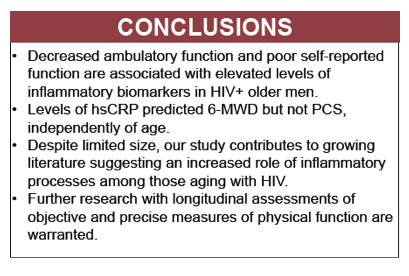 |
 |
 |
| |
Physical Function and Inflammation in Older HIV-Infected Men
|
| |
| |
Reported by Jules Levin
CROI 2017 Feb 14-17 Seattle, WA
HA McClintic1, MS Freiberg2, S Crystal3, DA Leaf4, JA Womack5,7, K Nieves-Lugo6, JP Tate7,8, K Crothers9, AC Justice7,8, KK Oursler1,10
1Virginia Tech Carilion School of Medicine, Roanoke, VA, USA; 2Vanderbilt University School of Medicine, Nashville, TN, USA; 3Rutgers University, New Brunswick, NJ, USA; 4UCLA School of Medicine, Los Angeles, CA, USA; 5Yale School of
Nursing, New Haven, CT,
USA; 6George Washington University, Washington, DC, USA; 7VA Connecticut Healthcare System, West Haven, CT, USA. 8Yale University School of Medicine, New Haven, CT, USA; 8University of Washington
School of Medicine, Seattle, WA, USA; 10Salem VA Medical Center, Salem, VA, USA

Abstract Body:
Aging with HIV infection is often characterized by chronic inflammation, multimorbidity, and frailty distinguished in part by decreased physical function. However, the relationship among these factors is not well understood and varies by the measure of function. We previously found in older HIV+ that the six-minute walk distance (6-MWD) correlates with cardiopulmonary fitness and lung function and further, that the survey-based physical health composite score (PCS) predicts mortality independently of comorbidity. Our current objective is to better understand the relationship between physical function and inflammation by comparing the association of the 6-MWD and the PCS with a panel of biomarkers of inflammation.
This is a cross-sectional study of 177 HIV+ men enrolled in the Veterans Aging Cohort Study (VACS) without prior diagnosis of cardiovascular disease. The 6-MWD test was performed at least 48 hours from blood sampling for IL-6, hsCRP, TNFα, sTNFrI, and sTNFrII. The physical health composite score (PCS) was derived from SF-12 survey items with a higher number representing better function. The association of 6-MWD and PCS with log transformed level of biomarkers was determined by Spearman's correlation and age-adjusted linear regression models.
The mean (SD) age was 54.5 (7.3) years and 80% were African American race. The mean (SD) 6-MWD was 499 (82) meters, which was 21% lower than age/gender predicted value. The median (IQR) PCS was 49.6 (39.9-54.7). There was a modest correlation between 6-MWD and PCS (ρ= 0.16, p=0.04). Both 6-MWD and PCS correlated with IL-6 and sTNFrI (Table). Only 6-MWD correlated with hsCRP. In age-adjusted linear regression models, the association of 6-MWD and hsCRP was the only relationship that remained significant. A log increase in hsCRP level was associated with a decrease of 16 meters in the 6-MWD with adjustment for age (β= -16.1, 95%CI (-25.4, -6.9)).
Decreased ambulatory function and poor self-reported function are associated with elevated levels of biomarkers of inflammation in HIV+ older men. Levels of hsCRP predicted 6-MWD but not PCS, independently of age. While limited in size, our study contributes to a growing literature suggesting that inflammatory processes may play a greater role among those aging with HIV. Further research with longitudinal assessments of objective and precise measures of physical function are warranted.



|
| |
|
 |
 |
|
|